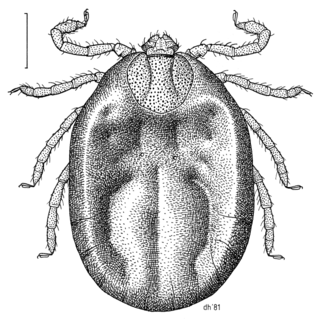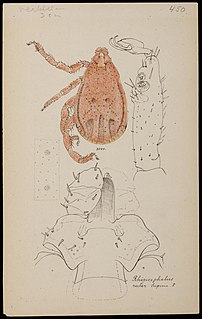Kyasanur forest disease (KFD) is a tick-borne viral haemorrhagic fever endemic to South-western part of India. The disease is caused by a virus belonging to the family Flaviviridae. KFDV is transmitted to humans through the bite of infected hard ticks which act as a reservoir of KFDV.

The white-cheeked barbet or small green barbet is a species of Asian barbet found in southern India. It is very similar to the more widespread brown-headed barbet, but this species has a distinctive supercilium and a broad white cheek stripe below the eye and is found in the forest areas of the Western Ghats, parts of the Eastern Ghats and adjoining hills. The brown-headed barbet has an orange eye-ring but the calls are very similar and the two species occur together in some of the drier forests to the east of the Western Ghats. Like all other Asian barbets, they are mainly frugivorous, and use their bills to excavate nest cavities in trees.

Haemaphysalis longicornis, the Asian longhorned tick, longhorned tick, bush tick, Asian tick, or cattle tick, is a parasitic arachnid belonging to the tick family Ixodidae. The Asian longhorned tick is a known livestock pest, especially in New Zealand, and can transmit a disease called theileriosis to cattle but not to humans. However, the tick has been associated with several other tickborne diseases in humans.
Langat virus (LGTV) is a virus of the genus Flavivirus. The virus was first isolated in Malaysia in 1956 from a hard tick of the Ixodes genus. This virus is antigenically related to Omsk hemorrhagic fever virus, Kyasanur forest disease virus, Alkhurma virus, Louping ill virus and other viruses of the tick-borne encephalitis virus (TBEV) complex. The Langat virus does not pose a significant epidemiological threat in comparison with TBEV. There are no known cases of human diseases associated with LGTV. The Malaysian strain is naturally attenuated and induces neutralizing antibodies to tick-borne encephalitis virus (TBEV) and protection against other TBEV complex viruses in animals.
The Bhanja virus is a tick-borne virus first discovered in a tick taken from a paralyzed goat in Bhanjanagar, India in 1954. Bhanja virus in humans was first documented in 1974 when Charles Calisher was working with the virus in a lab and contracted it himself. His experience with the virus was mild and included symptoms of mild aching in muscles and joints, moderate headache, slight photophobia. The Bhanja virus is a member of the Bhanja virus serocomplex and is a member of the Bunyavirales order.
Pylore Krishnaier Rajagopalan is an Indian vector control scientist, biologist and acarologist, known for his pioneering contributions to the control programmes against vector-borne diseases in India.[1] He is a former director of the Indian Council of Medical Research managed Vector Control Research Centre, Pondicherry.[2][3] He graduated in 1949 from the Banaras Hindu University and obtained a Masters in Zoology with University First Rank there itself in 1951. In 1952 he joined the fledgling Virus Research Centre in Pune, and worked under the supervision of some of the finest vector control specialists such as Dr T Ramachandra Rao. In recognition of his outstanding work as a young research scientist, in 1957 he was awarded a Fellowship by the Rockefeller Foundation to pursue a Master's program in Public Health from the University of California.[4] He went on to secure a Diploma in Acarology from the University of Maryland at College Park.
Ixodes petauristae is a hard-bodied tick of the genus Ixodes. It is found in India and Sri Lanka. Adults parasitize various smaller mammals such as Ratufa indica, Funambulus tristriatus, Macaca radiata, Petaurista sp. and mice. It is a potential vector of Kyasanur Forest disease virus,
Ixodes ceylonensis is a hard-bodied tick of the genus Ixodes. It is found in India and Sri Lanka. It is an obligate ectoparasite of mammals.
Haemaphysalis aculeata is a hard-bodied tick of the genus Haemaphysalis. It is found in India and Sri Lanka.
Haemaphysalis bispinosa is a hard-bodied tick of the genus Haemaphysalis. It is found in India, Sri Lanka, Myanmar, Pakistan, Nepal, Australia, and Indonesia. It is an obligate ectoparasite of mammals. It is a potential vector of Kyasanur Forest disease virus. These ticks was found parasitized by a chalcid Hunterellus sagarensis in these diseased areas.
Haemaphysalis anomala is a hard-bodied tick of the genus Haemaphysalis. It is found in India, Vietnam and Sri Lanka. It is an obligate ectoparasite of mammals.
Haemaphysalis cuspidata is a hard-bodied tick of the genus Haemaphysalis. It is found in India and Sri Lanka. It is a potential vector of Kyasanur Forest disease virus.
Haemaphysalis hystricis, the East Asian mountain haemaphysalid, is a hard-bodied tick of the genus Haemaphysalis. It is found in India, Sri Lanka, Vietnam, Myanmar, China, Japan, India, Indonesia, Laos, Taiwan and Thailand. It is an obligate ectoparasite of mammals. It is a potential vector of Kyasanur Forest disease virus, Coxiella sp., Ehrlichia sp., and Rickettsia japonica. In 2007, an unknown trypanosoma species known as Trypanosoma KG1 isolate was isolated from naturally infected H. hystricis ticks.
Haemaphysalis intermedia, the flat-inner-spurred haemaphysalid, is a hard-bodied tick of the genus Haemaphysalis. It is found in India and Sri Lanka. It is an obligate ectoparasite of mammals. It is a potential vector of Kyasanur Forest disease virus, Ganjam virus, and Nairobi sheep disease virus.
Haemaphysalis spinigera, is a hard-bodied tick of the genus Haemaphysalis. It is found in India, Sri Lanka, Vietnam. It is an obligate ectoparasite of mammals of various rodents, insectivores and monkeys. It is a potential vector of Kyasanur Forest disease virus, and Kaisodi virus.
Haemaphysalis turturis, is a hard-bodied tick of the genus Haemaphysalis. It is found in India and Sri Lanka. It is an obligate ectoparasite of mammals. It is a potential vector of Kyasanur Forest disease virus, and ganjam virus.
The Sharif's Indian Hyalomma,, is a hard-bodied tick of the genus Hyalomma. It is found in India and Sri Lanka.
Nosomma monstrosum, is a hard-bodied tick of the genus Nosomma. It is found in India, Bangladesh, Sri Lanka and Vietnam.

Rhipicephalus haemaphysaloides is a hard-bodied tick of the genus Rhipicephalus. It is one of the major medically important ticks in the world.



